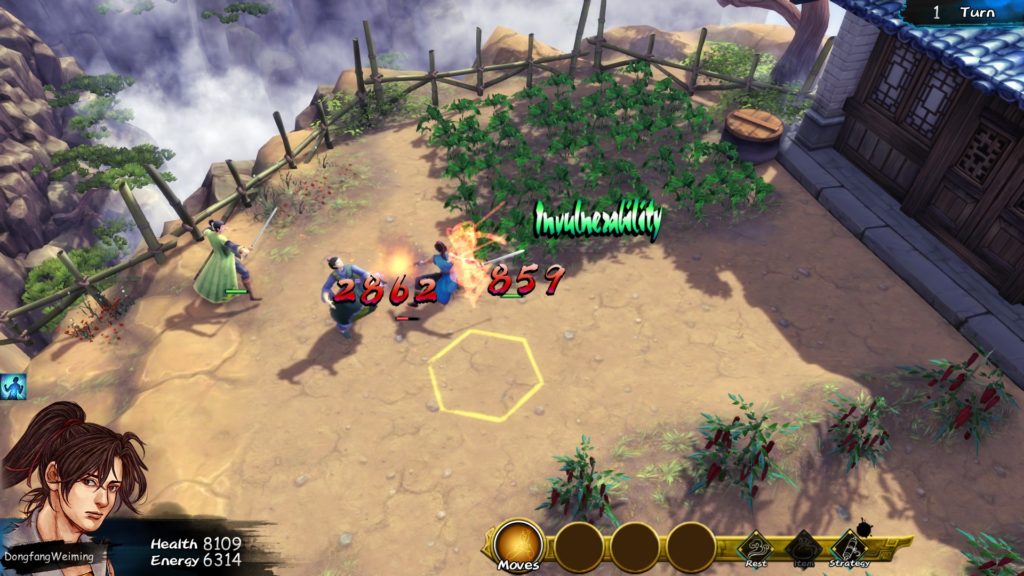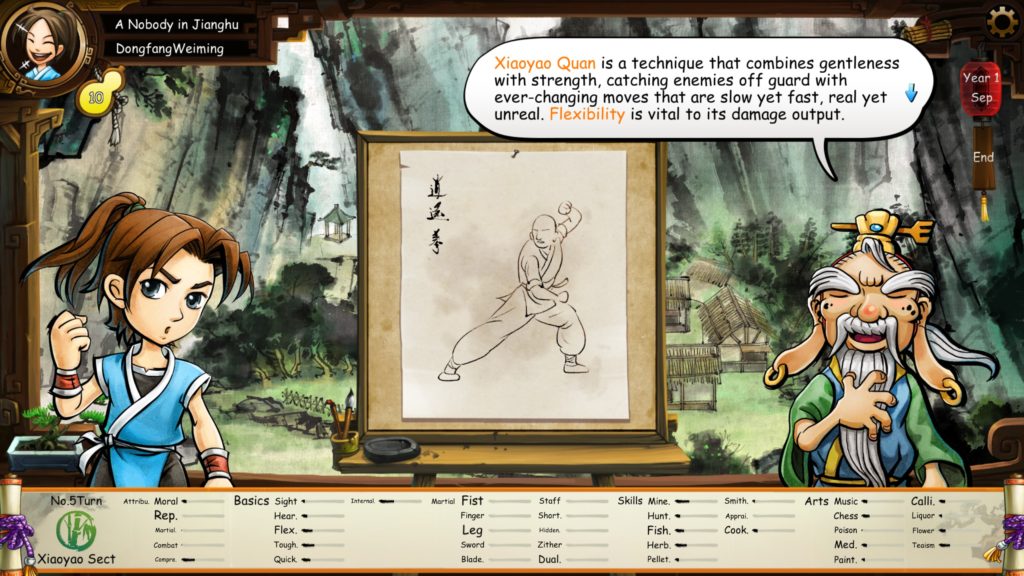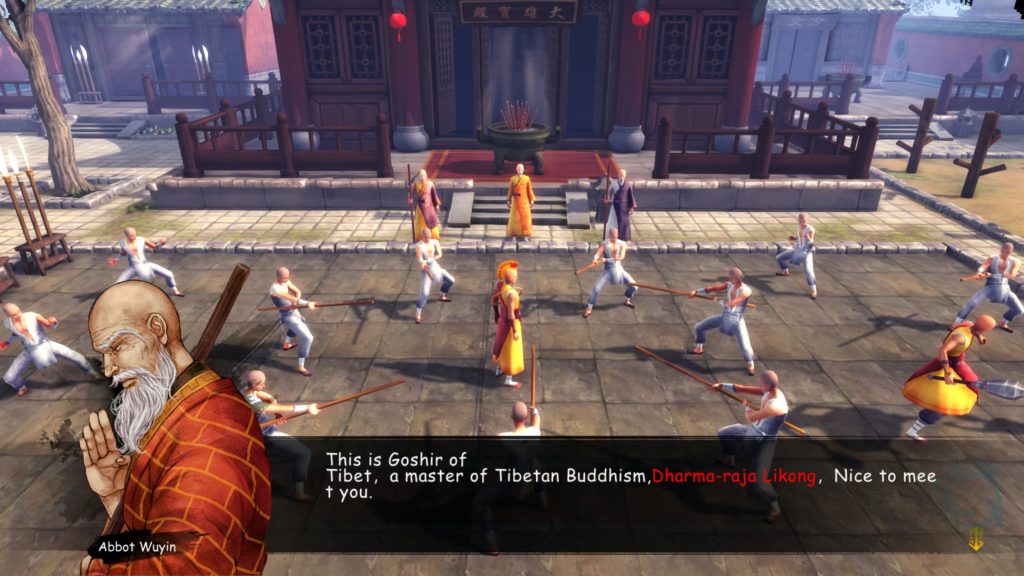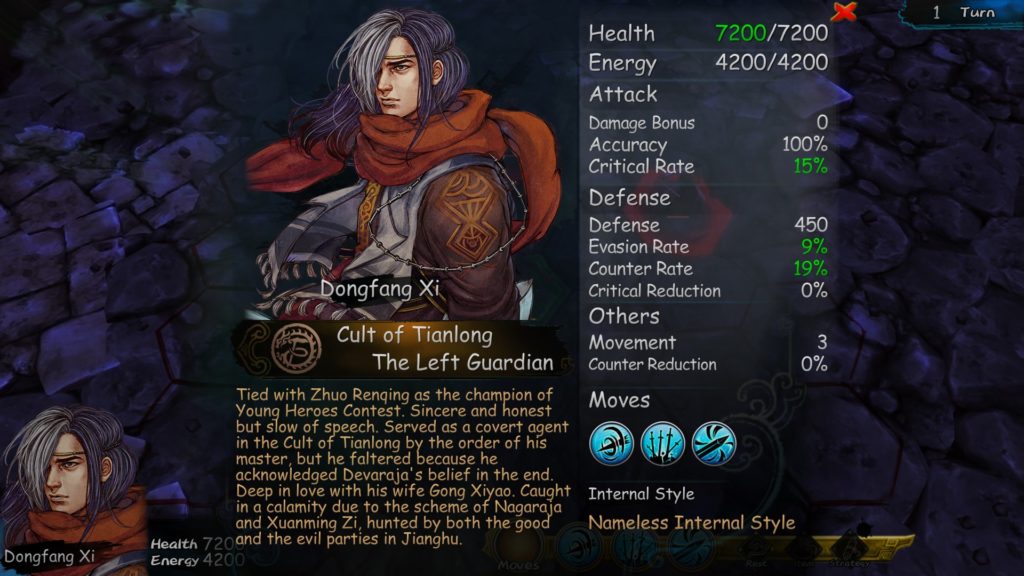
I picked this up in the interests of trying out more title in the genre of Chinese RPGs. This one is apparently a classic of the genre, being a modern remake of an older and very famous game. As I understand it, the original game held an official license for using the intellectual property of Jin Yong. This sequel doesn’t possess the license any longer and so does away with the more direct references. But it is still crammed with pretty much every kung fu that ever appeared in every one of his novels, plus much else including that of Gu Long. Basically any famous martial art, clan, trope or item you can think of in wuxia, you will be able to find it here.
The basic idea here is to more or less closely replicate the typical story of your usual wuxia protagonist. You’re an orphan who has always admired the legendary hero Nobody and dream of becoming a martial artist yourself. One day in the village of Dukang, you selflessly throw yourself into rescuing a damsel in distress despite knowing no kung fu whatsoever. Fortunately you are rescued by Gu Yuexuan, the senior disciple of Xiao Yao Valley. When you are accidentally poisoned by one of their enemies, you are brought to the valley to be cured by their master Wuxia Zi and naturally taken on as a disciple. Things are quiet at the beginning as you train and meet with the members of the other sects. Eventually you will be caught up in larger events involving the evil Tianlong cult perhaps the Emperor.

Gameplay takes place across a number of different modes. For example you start the game in the village in a top down view and get to run around the map talking to people and doing quests much like other RPGs. Combat is turn-based on a hex grid of the same map. However you have a limited amount of real time in this mode and once this phase is over you switch to a turn-based training mode. This amounts to time management as you decide turn-by-turn whether to spend time training various types of kung fu, doing chores, learning art and crafting skills, or simply strolling out in search of adventure. You spend a total of about four years like this, punctuated by scripted events that involve you visiting different cities and doing quests in them. Only towards the very end of the game, you’re given free rein over the world map though at that point you’re not allowed to train any longer.
As you can see from these screenshots, the different modes actually have different art styles as well as I find aesthetically displeasing. Furthermore there are a profusion of mini-games in here most of which I find to be childish and extremely annoying. For example mining involves a literal whack-a-mole mini-game in real time while painting is a kind of jigsaw puzzle game. There’s one for almost every activity in the game and even there aren’t, there are still memorization puzzles and quizzes. So as part of learning music, you’re required to listen to some short melodies and remember them while learning medicine calls for memorizing the acupuncture chart for meridians. Since doing production activities can boost stats and the items that you can get from mining are quite important, playing these mini-games is not exactly optional either.

Ironically enough for a wuxia RPG, you spend far less time fighting than playing those mini-games. There isn’t really any grinding against trash mobs in this game. Every fight is part of a scripted event or quest. That actually seems kind of strange to me, if mining can be a mini-game why not have training a martial art be a one-on-one fight using only that art? Thankfully the combat actually does have enough depth in it to be reasonably fun. Each martial art style only has two or three moves and the more powerful ones have cooldowns but you can switch between styles using the same weapon. There are also substantial bonuses for attacking enemies from behind or from the sides and naturally when your move as an area of effect you’ll want as many enemies in range as you can. In addition you also equip an internal style, each of which provides different passive benefits. The beginner Xiao Yao Internal Style for example allows you to regenerate a portion of your health and energy every turn.
Combat difficulty is all over the place. It’s tough at first when your character has almost no kung fu so you’ll have to rely on your companions and occasionally items to tide you over. But unless you’re totally hopeless at min-maxing character builds for RPGs, you’ll soon enough become so powerful as to utterly dominate everyone. So does that mean that all fights after that point become a cake walk? Far from it, because even the battles are scripted events and the enemies are given insane buffs and free health refills that are impossible for you to predict. The end boss is fully capable of one-shotting all of your allies in a single attack. Enemies will become allies and allies will become enemies new enemies will appear and allies will eventually arrive to help you all according to the script. It’s a crazy mess that should you win, it’ll feel like blind luck.

This kind of obnoxious disregard for player agency and outdated design pervades the entire game. By default cutscenes are not skippable and you can’t even access the main menu during battles, to reload to a save when you want a redo for example. There’s no in-game map during the scenes scenes and no way to track quests. Since time passes in the town scenes and the NPCs have move according to a schedule, you will very easily miss out on many quests. Some items that you obtain are meant to be kept for quests but naturally the game doesn’t tell you that either so you end up consuming it yourself or selling it as vendor trash. Even the character generation system at the beginning of the game is completely random. Don’t like the character the game gives you? Reroll! Imagine that in this day and age. Plus don’t even think that you can customize your character’s appearance. Sure, you can choose a name and between a few different poses of the exact same face. But you can never choose what clothes are worn nor what the colors are.
The main plot itself and side stories are the usual wuxia staples but that is exactly what is needed for a game like this. Do note that the game expects you to romance an entire harem of beauties exactly as in the stories and that might be a bit of a turn-off for some. There are multiple endings though unless you know exactly what you are doing it may be difficult to get anything other than the default Alliance leader ending. This depends on events and decisions made while strolling and even who you romance. Since everything depends on the scripted events and very often there are prerequisites in terms of skills in order to pass these events successfully, it’s impossible to chart a path through them without prior knowledge. You really do need to refer to a guide to understand what you need and this goes as well for qualifying for certain arts or obtaining specific items or even knowing that some quests exist.

All this make it sound like this is a terrible game and in many ways it is. Yet it oozes so much atmosphere and it is so cool to learn and use famous martial arts like the Dugu 9 Swords or the 18 Dragon Subduing Palms that you feel tempted to persevere anyway. It’s a lot of fun to run around the towns meeting characters from all of the different sects and participating in their stories. It feels exactly like living in the world of the Jin Yong books and for the generation that grew up with them, that can be priceless. The combat system is interesting enough that your builds feel meaningful and who doesn’t want to try out all the different styles and weapons? It’s easy to see why this game is considered by Chinese gamers to be a classic.
If only this wasn’t just a remake but a redesign that takes into account everything that we’ve learned about game design since the original game was first made, this would have been so great. Properly balanced RPG mechanics, quests and NPCs that don’t rely on obfuscation to be difficult, maybe even a more consistent art style would do wonders. Furthermore do note that while most of the game has been translated into English, you do still run into parts that have not, so that can be a problem for those who don’t read Chinese. For my part, I powered through to the end, or at least one ending, but it was a chore and I’m not sure I can recommend it to anyone.